How to Can Tomato Soup Without a Pressure Cooker
Canning Lycopersicon esculentum Soup Base {Homemade Canned Tomato plant Soup}
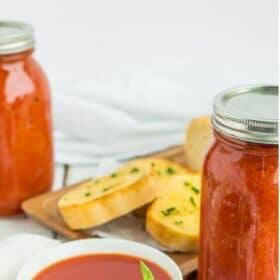
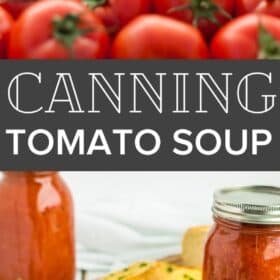
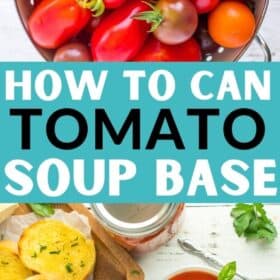

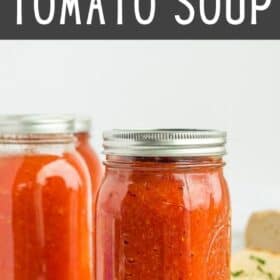
Follow this step-by-footstep tutorial to larn how easy Canning Tomato Soup tin can be. The ultimate comfort nutrient, this love apple soup base recipe can be pressure canned or preserved via water bath canning.
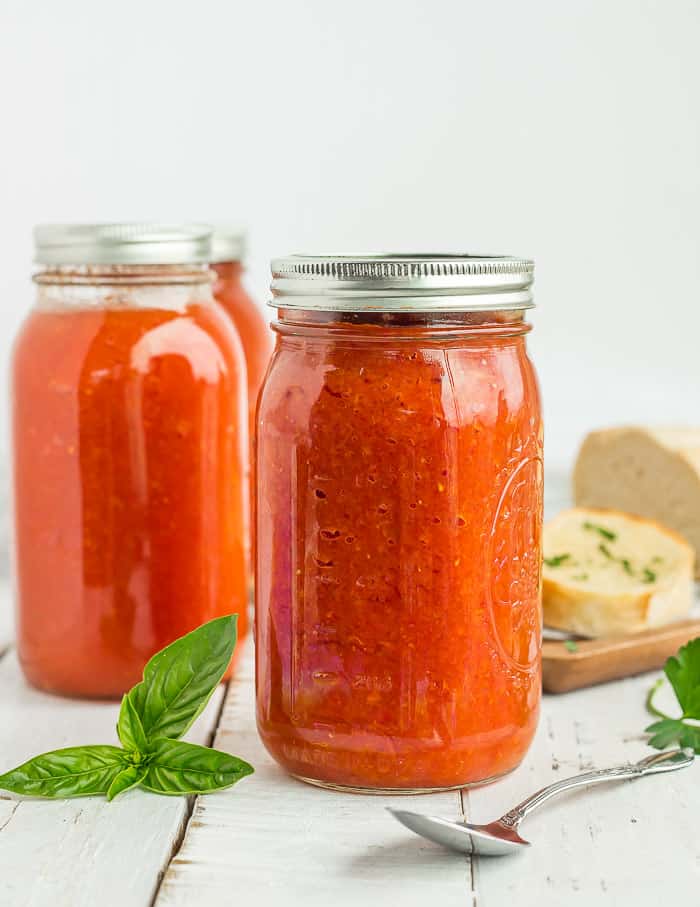
Every bit an Amazon Acquaintance, I earn from qualifying purchases.
Bootleg love apple soup is amazing and tastes so fresh, but peeling and pureeing tomatoes each time you want soup is super time-consuming. Not to mention that love apple season is only like six week long here in Seattle.
So what is a soup-obsessed girl to do? Can her own tomato soup base!
Which Tomatoes Are Best For Canning Love apple Soup?
Piece of cake answer – whatever tomatoes you take! Paste-fashion tomatoes are thicker and have fewer seeds, but their flavor is not usually very exciting.
Throughout the growing season, I'1000 busy canning (whole) tomatoes and canning stewed tomatoes, just I save canning lycopersicon esculentum soup for the end of the season when all that is left are the random tomatoes. Random tomatoes brand the best soup because you go all the complex amazing tomatoey flavor in one delicious bowl.
You need nigh 45 pounds of tomatoes for fourteen pints or 7 quarts. Since I never have that many at once, I do small batch canning and might produce 1-4 quarts at a time. It all eats the same.
Pro tip: if you abound your own tomatoes and don't accept enough to can at one time, you tin freeze them on blistering trays and and so transfer to freezer numberless (I love these reusable silicone bags) until yous have a disquisitional mass for canning.
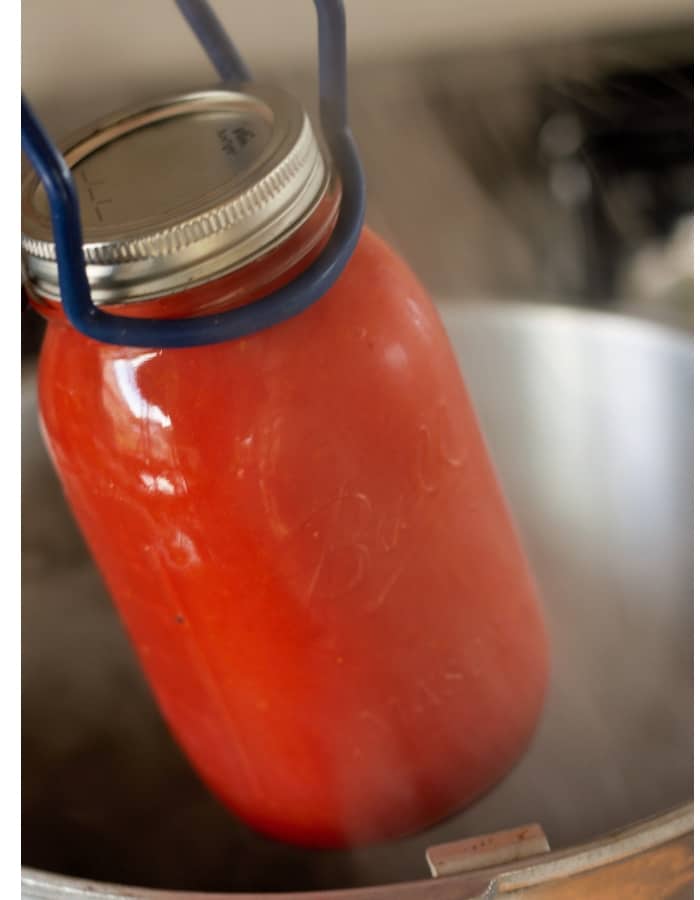
Why Do I Need Bottled Lemon Juice?
The lemon juice is needed to regulate the acidity of the tomatoes to keep the ph level consequent. Storebought lemon juice generally has the same level of acidity (5%) from bottle to bottle. You don't get that guarantee with freshly squeezed lemons.
Canning Supplies
Check out this in-depth mail for a complete list of canning supplies.
Y'all'll need:
- Tomatoes (no surprise there)
- Bottled lemon juice or citric acid
- Pressure level Canner or water bathroom canner
- Large saucepan (I utilise my enameled dutch oven)
- Canning funnel
- Pint or quart canning jars (thrift stores are my favorite sources for these!)
- New lids and clean rings
- Jar lifter
- Big mixing basin
- Strainer
- Plastic chopstick or another long plastic utensil
- Food mill (optional only highly recommended)
- Slotted spoon
- Ice
- Clean towels – 2 big ones for the counter, and 2 make clean washcloths
- Comfy shoes
How to Can Lycopersicon esculentum Soup (Pressure Tin) – Step by Pace
I'll walk you lot through the process here in photos because information technology really helps, especially if you're new to canning. At the bottom of the post, yous'll also discover a printable and detailed recipe card. The recipe card also contains water bath canning instructions if you don't desire to pressure tin this soup.
Rinse all your crawly tomatoes and cut them in half. If you take big ol' hunkers, then cut them into smaller chunks. Add a strainer/colander to a large basin.
Launder and make clean your jars. For canning soup, I recommend quart-sized regular mouth jars. It is no longer necessary to sterilize jars before canning (hurray!) just you lot should make sure they are preheated enough to not crack when placed in hot water.
Yous can put them in a clean dishwasher and run them through a quick launder bike, or place them in a large pan with some water in a depression oestrus oven (my lowest temp is 170 degrees) until yous need them. I've even just put hot tap water in them before and left them on the counter.
Wash your lids with hot soapy water and place them in a clean bowl for now.
Add the tomatoes to a pot of boiling water and parboil them until you lot run across the skins start to come off one of the tomatoes (virtually 1-2 minutes). You tin read a more in-depth tutorial on How to Flinch and Skin Tomatoes.
Apply a slotted spoon and remove the tomatoes and identify in the strainer.
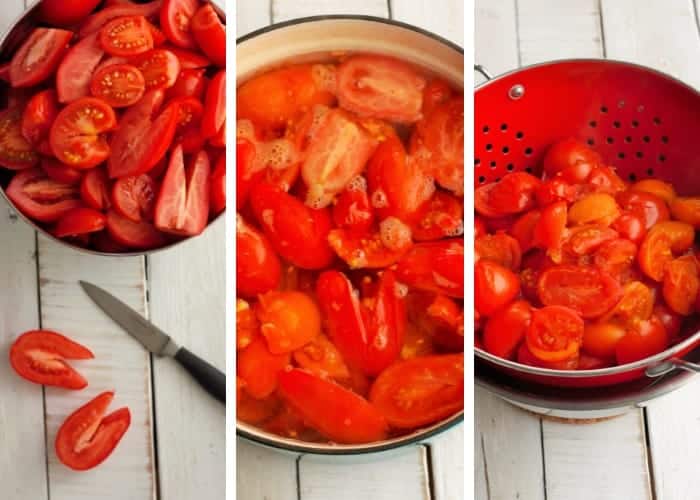
Run the tomatoes through a nutrient mill to remove the seeds and skins. If my tomatoes are particularly watery, I will strain them a bit through a mesh strainer.
Pro tip: when you have a basin completely full of skins and seeds, run them through the nutrient mill two more times. I always go almost an actress quart out of these scraps.
Transfer the tomato puree to a pot over low heat or a crockpot set to low. Keep warm until ready to tin can.
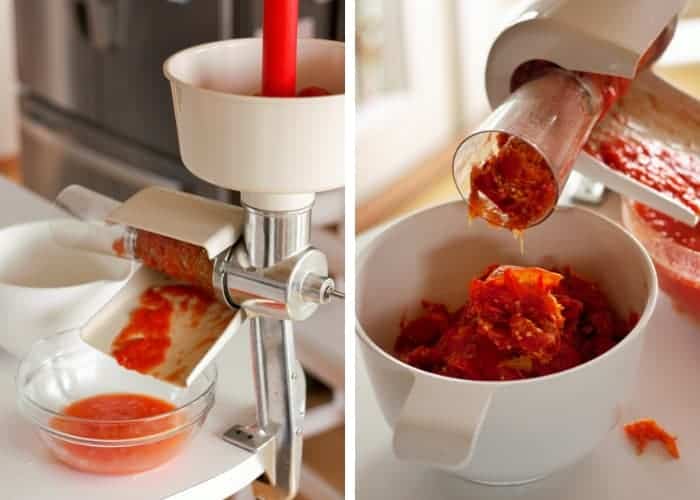
Add iii quarts of water to your canner and put it on a burner set to high. Make certain there is a canning rack in the bottom of the canner. ( Reminder: these are pressure level canning instructions. Meet the recipe card for water bathroom canning details).
Place a funnel on a canning jar, add the lemon juice or citric acid, and ladle in the warm tomato puree, leaving 1 inch of headspace. Headspace is defined as the space betwixt the top of the soup and the peak of the jar. Remove whatsoever bubbles from the jar (I use a plastic chopstick).
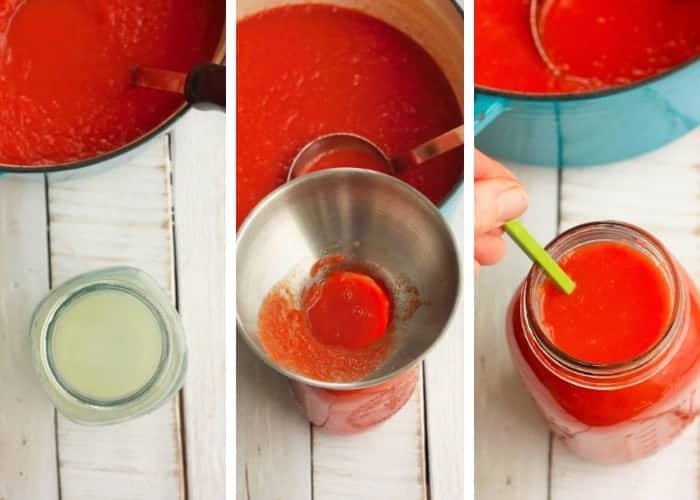
Use a wet clean rag and wipe the rim of the jars to make sure they are free of whatsoever nutrient.
Place a clean lid and so a ring on the jar and tighten the band to fingertip tight (tight enough that it won't come off, but not and so tight that the Hulk couldn't budge it).
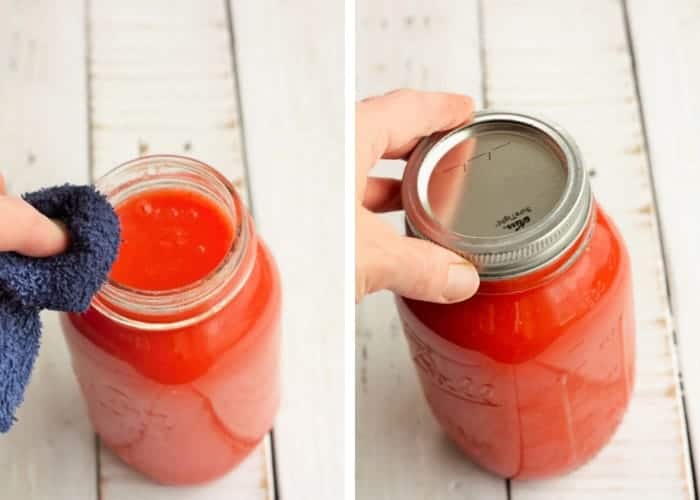
Identify the jars in the canner. If you lot don't have enough jars to fill up the canner, consider Canning H2o in a few jars to stock your emergency drinking water supplies.
Lock the lid. Soon, steam volition first coming through the vent piping (I call information technology the steam chimney). Allow the steam to pass through for about 10 minutes. Then put the pressure regulator (I call information technology the chimney cap) on acme.
Pretty soon, the air vent will pop upwardly. That is a sign that yous're starting to build pressure level inside the canner.
Under normal conditions, lycopersicon esculentum soup needs to exist pressure level canned at xi pounds of pressure for 15 minutes for both pints and quarts. See chart below for whatever changes to processing times.

When the dial guess reaches 11 pounds of pressure, reduce the burner temp to medium, and start your timer for xv minutes. The pressure must stay at 11 or (a little fleck) above for the next 15 minutes.
You'll likely need to adjust the temp on the burner a few times depending on your stove.
When the 15 minutes are up, remove the canner from the burner and permit it to sit until you hear a distinctive "click" of the air vent dropping. Remove the force per unit area regulator and carefully remove the lid ( Pro tip : I e'er utilise oven mitts when I have the lid off because the steam is crazy hot).
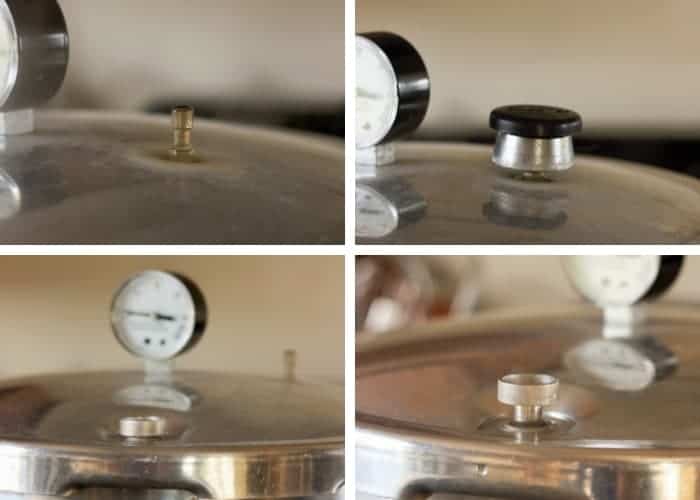
Let the jars sit for five minutes in the canner and then elevator them out with canning tongs. Place on a towel where they tin sit undisturbed for 12 hours.
Afterward a few hours, to bank check for sealing, gently press downwardly in the middle of the chapeau. If the chapeau has no give, it's sealed. If you can printing the lid in and it pops a bit, your jars are not sealed. You can reprocess them or shop them in the fridge or freezer (only freeze jars that are wide mouth). Shop in a cool dry place for up to 12 months.
Ok, And so Why Can't I Add Spices and Stuff to This Soup? Huh, Bossy Pants?
When you are canning with lower acid foods you don't desire to mess with any of the tried and true and TESTED recipes. Also much of one ingredient or as well niggling of another tin throw off the safety of your final product.
Instead, I treat this recipe as a base, much like you would if you bought a tin can at the store. But when cooking with it, I never just add water; it's more than fun and flavorful to medico it up. Check out this recipe for my favorite gluten-free tomato soup recipe.
Why Practice I Demand to Remove All the Seeds and Skins?
Gosh, information technology would exist so much easier to just blend the tomatoes whole, right? Technically yous don't need to remove the seeds and pare, simply I find too many seeds volition plow your soup completely bitter; what a waste. Skins tin likewise give your final product a weird texture and throw off the taste.
If you're in a rush, canning whole tomatoes might be more up your alley. And they're super versatile and easy to use in soups and stews. Or you could even dehydrate tomatoes.
More Recipes Like This
- Canning Peaches – How to Tin can Peaches
- How to Brand Tomato Powder
- How to Can Beets
- Canning Peas
- How to Can Potatoes
- Canning Corn
- Dill Pickle Relish – Canning Savour
- Canning Pears
- How to Tin Greenish Beans
- Blackberry Syrup
- Canning Applesauce
- Bank check out all my canning recipes!
Canning Lycopersicon esculentum Soup Base
Follow this pace by stride tutorial to learn how to can tomato soup.
- twenty lbs tomatoes
- 10 tbsp lemon juice {divided}
Force per unit area Canning Tomatoes
-
Rinse the tomatoes and cut in half, or quarters for larger tomatoes.
20 lbs tomatoes
-
Add a strainer/colander to a large bowl.
-
Wash and sanitize your jars. Yous'll want to continue them warm to avoid having them crack when placed in the canner. You can fill them with hot h2o, or place them on a tray in the oven at 170F.
-
Wash your lids with hot soapy water and place them in a make clean bowl for now.
-
Add the tomatoes to a pot of boiling water and parboil them until you encounter the skins offset to come off i of the tomatoes (nearly 1-ii minutes).
-
Apply a slotted spoon and remove the tomatoes and place in the strainer.
-
Run the tomatoes through a food mill to remove the seeds and skins.
-
Transfer the love apple puree to a pot over depression estrus or a crockpot set to depression. Keep warm until ready to can.
-
Add together iii quarts of water to your pressure canner and put it on a burner set to loftier. Make sure at that place is a canning rack in the bottom of the canner.
-
Add together lemon juice or citric acrid to your canning jars.
Quarts: 2 tbsp lemon juice OR ane/two tsp citric acid. Table salt (optional) 1 tsp
Pints: 1 tbsp lemon juice OR 1/4 tsp citric acrid. Salt (optional) 1/2 tsp
10 tbsp lemon juice
-
Place a funnel on a canning jar and ladle in the warm tomato puree, leaving 1 inch of headspace. Headspace is defined as the space betwixt the top of the nutrient and the top of the jar.
-
Using a long utensil (I prefer a plastic chopstick), remove all the air bubbles from the jar.
-
Use a wet clean rag and wipe the rim of the jars to make sure they are costless of whatsoever nutrient.
-
Identify a make clean new hat on the jar. Add a ring, and tighten to fingertip tight.
-
Using canning tongs, gently identify the jars in the canner. Lock the hat. Soon, steam will start coming through the vent pipe.
-
Allow the steam to laissez passer through for about 10 minutes. Then put the pressure level regulator on summit. (see photos in postal service higher up to encounter this in activity)
-
Pretty before long, the air vent will popular up. That is a sign that you lot're starting to build pressure inside the canner. Love apple soup demand to be pressure canned at 11 pounds of pressure for 15 minutes for both pints and quarts. (see time chart in postal service for adjusted times for height and water bath canning).
-
When the dial gauge reaches eleven pounds of pressure, reduce the burner temp to medium, and beginning your timer. The pressure must stay at 11 or (a little bit) above for the duration of the cooking time. You'll probable demand to conform the temp on the burner a few times depending on your stove.
-
When the time is up, remove the canner from the burner and allow it to sit until y'all hear a distinctive "click" of the air vent dropping. Remove the pressure regulator and carefully remove the lid ( Pro tip : I always apply oven mitts when I take the hat off because the steam is crazy hot).
-
Permit the jars sit down for 5 minutes in the canner and and then lift them out with canning tongs. Place on a towel where they tin can sit down undisturbed for 12 hours.
-
Subsequently a few hours, to check for sealing, gently press down in the middle of the hat. If the lid has no give, it's sealed. If yous tin can press the lid in and it pops a bit, your jars are not sealed.
Water Bath Canning Tomatoes
-
Complete steps 1-8 above.
-
Fill up your canner so that at that place volition exist two inches of water over the tallest jar that you are canning. Prepare information technology on a big burner set to high.
-
Complete steps ten-fourteen above.
-
When the water has reached a rolling boil, place the jars in the canner and place the hat on top. Process pints for 35 minutes or quarts for 40 minutes.
-
When the time is upward, remove the canner from the burner and let the jars sit for five minutes in the canner and and so lift them out with canning tongs.
-
Place on a towel where they tin can sit undisturbed for 12 hours.
Typically, 45 pounds of tomatoes will brand 14 pints or 7 quarts of tomato soup.
Shop in a absurd dry out identify for up to 12 months.
Nutrition Facts
Canning Tomato Soup Base of operations
Amount Per Serving (0.5 cup)
Calories 83
% Daily Value*
Fat 0g 0%
Saturated Fat 0g 0%
Cholesterol 0mg 0%
Sodium 22mg 1%
Potassium 1082mg 31%
Carbohydrates 18g 6%
Fiber 5g 21%
Saccharide 12g 13%
Protein 4g 8%
Vitamin A 3780IU 76%
Vitamin C 65mg 79%
Calcium 45mg 5%
Atomic number 26 1.2mg seven%
* Percent Daily Values are based on a 2000 calorie diet.
Shop this Post:
(may include affiliate links)
bellangerprackentind.blogspot.com
Source: https://www.sustainablecooks.com/canning-tomato-soup/
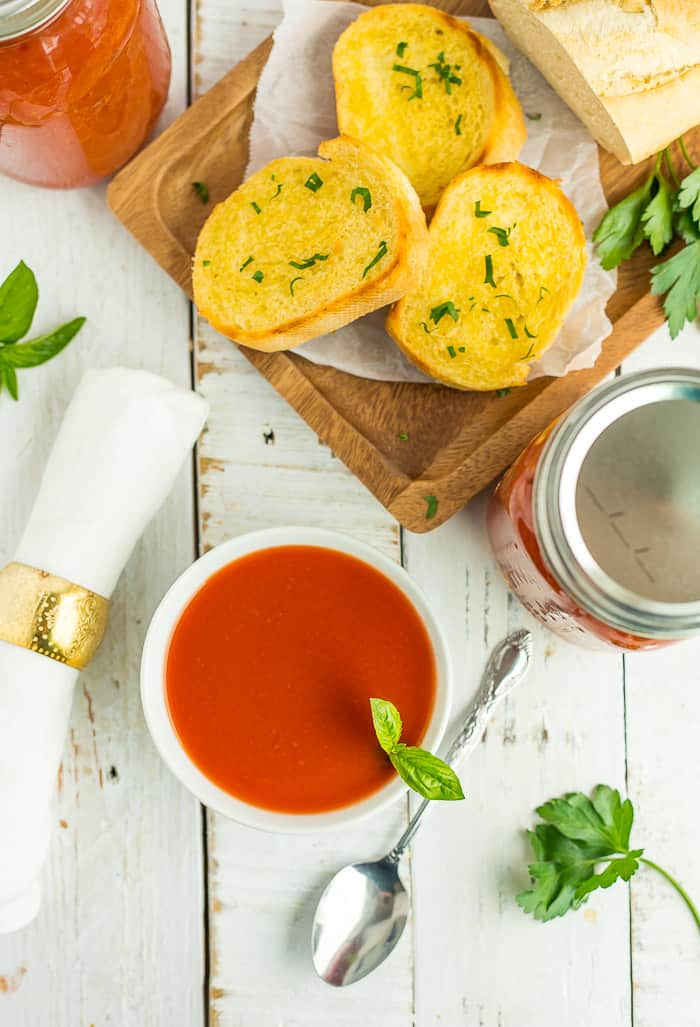
0 Response to "How to Can Tomato Soup Without a Pressure Cooker"
ارسال یک نظر